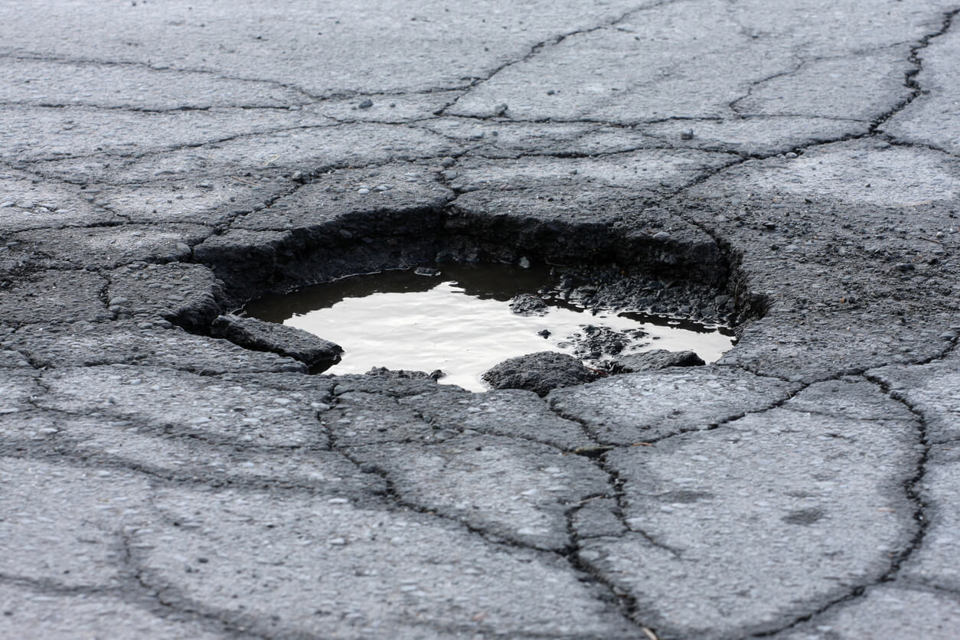Fleets endured a winter of discontent, with pothole-related breakdowns on the rise, according to newly released figures. Despite mild and comparatively dry winter conditions, the RAC’s patrols attended 63% more pothole-related breakdowns in the first quarter of 2017 than they did over the same period in 2016.
In total, it dealt with more than 6,500 breakdowns between January and March which were likely to be attributable to poor road surfaces. The last time so many pothole-related breakdowns were recorded was in the first quarter of 2015, when patrols were called out to nearly 6,900 such breakdowns. That quarter, however, saw both more frost days and rainfall than the equivalent period this year.
Nine out of 10 respondents to a recent Fleet News poll said they had not seen any improvement in the state of roads in the UK despite more funding being allocated to pothole repairs.
One reader told Fleet News: “On average I have to replace two tyres and have one alloy repaired each winter.”
Another said: “The roads are worse than ever. I seriously believe that if it continues we will need caterpillar-tracked vehicles soon. My suspension is rattling again – looks like another £400 bill is coming. It’s a disgrace.”
The Government announced that £70 million would be shared across local highway authorities in England, outside of London, earlier this year. The investment was in addition to a £50m pothole repair fund which was announced in the 2016 spring budget.
However, the Annual Local Authority Road Maintenance (ALARM) survey, published by the Asphalt Industry Alliance (AIA), reported that local authorities need more than £12 billion to bring the network up to scratch.
Nick Hardy, sales and marketing director at Ogilvie Fleet, told Fleet News: “We would prefer to see more investment in the road infrastructure which would help reduce the problems and costs of potholes.
“It isn’t just the actual damage caused, it’s also the time lost in downtime for the driver and everyone else associated with the incident. I shudder to think what the actual costs are when you factor in the driver’s downtime and lost productivity.”
When considered in the context of all RAC breakdowns, the share of pothole-related call-outs in Q1 2017 equated to 2.7% of all RAC jobs – this is the largest quarterly figure seen since the RAC’s pothole analysis began in 2006.
However, the latest figures do also offer a glimmer of hope for fleets as the longer term picture is an improving one.
The RAC Pothole Index, a rolling average of pothole-related breakdowns which is corrected to remove unrelated longer term effects of weather and improving vehicle reliability, currently stands at 2.08, its lowest value since the last quarter of 2008. This suggests that – looking at breakdowns over a much longer time period – the overall quality of the UK’s road surfaces is beginning to get better, though still well short of their condition a decade ago.
Indeed, the ALARM survey shows the maintenance backlog is largely unchanged over the past year. This suggests that the slow improvement is a result of a combination of favourable weather and the dedicated pothole repair fund from central government.
However, AIA data indicates most local authorities still cannot afford to make in-roads into the backlog of preventative maintenance that would stop potholes forming in the first place.
RAC chief engineer David Bizley said: “Anyone that has experienced a breakdown as a result of hitting a pothole will know just how frustrating that can be – not to say dangerous and expensive if damage to their vehicle is sustained.
“Local authorities still have a huge funding gap in their roads budget and until central government is willing to ring-fence sufficient funding to bring local roads back into a state that is fit for purpose, their condition will be subject to the whims of the weather and they will continue to be the poor relation in the nation’s transport infrastructure.”





















Cliff Burton - 14/06/2017 00:53
Local authority funding has been slashed over recent years and, with more ‘pressing priorities’ such as education and adult social care demanding a larger slice of an even smaller pie, roads maintenance has simply fallen down the pecking order. Repairs have increased, but a couple of winters later the pothole returns as what is only being afforded is a quick fix. Did the Romans have these problems or did they understand the importance of an effective transport network?.